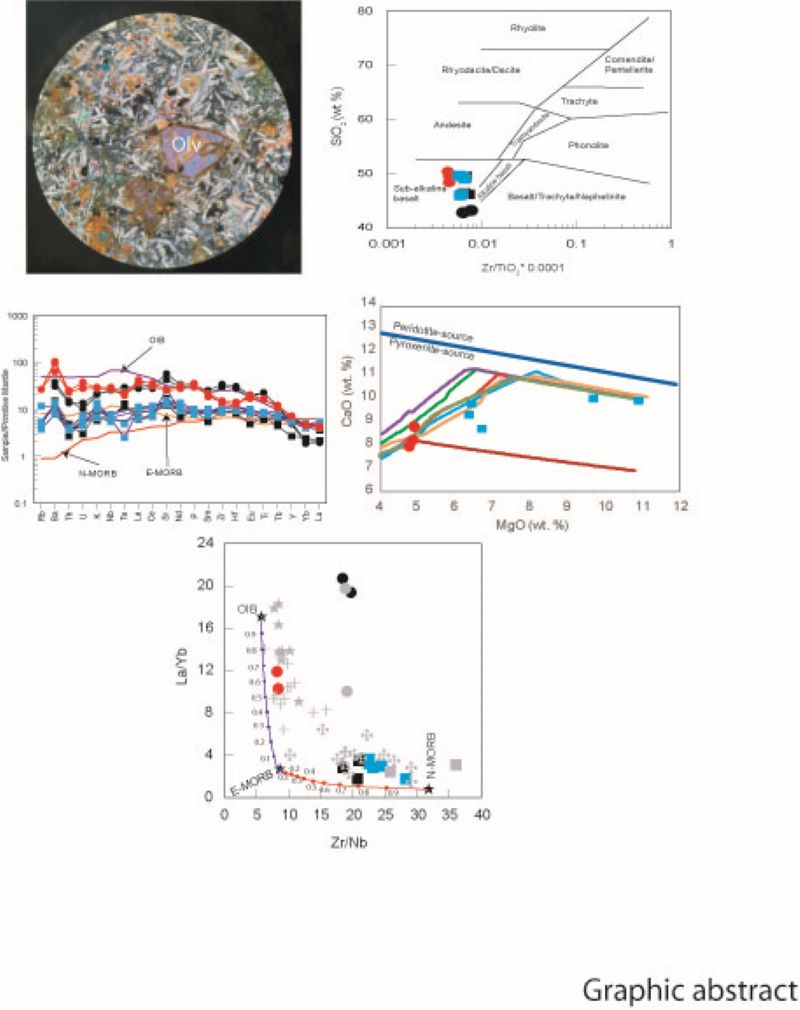
Geochemical characteristics of flood basalts from Adigrat area, northwestern Ethiopian Plateau: Implication for mantle source heterogeneity
ABSTRACT

Geochemical data are presented for flood basalts from the Adigrat area in the northwestern Ethiopian Plateau to determine their genesis and mantle source compositions. Stratigraphically, Adigrat flood basalts can be subdivided into upper and lower basalts that are both sub-alkaline in composition. The lower basalts show a wider range of MgO content (6.41–11 wt. %) relative to the upper basalts (4.77–4.9 wt. %). The geochemical variations between the upper and lower basalts cannot be explained by crystal fractionation from a common magma source but might reflect either the involvement of variable mantle sources or different depths and degrees of partial melting. The trace element patterns of the upper basalts resemble those of ocean island basalt (OIB), whereas those of the lower basalts are more akin to enriched asthenospheric mantle (E-MORB). Trace elements and their ratios show the involvement of at least three mantle components (OIB, E-MORB, and N-MORB) in the genesis of the Adigrat flood basalts. We envisage a scenario wherein the Oligocene continental flood basalts of the northwestern Ethiopia plateau were triggered by the arrival of the Afar mantle plume. Low-degree melts of the plume metasomatized the depleted asthenosphere (N-MORB component) and subsequently the thermal effect of the hot mantle plume triggered melting of the metasomatized asthenosphere (E-MORB component) in the garnet-spinel transition zone. The mixing of these E-MORB and N-MORB mantle components generated the lower basalts. decompression melting of the mantle plume generated an OIB component in garnet stability field, which mixed with the E-MORB component to produce the upper basalts.
KEYWORDS
Keywords: Adigrat, flood basalt, Afar plume, mantle source, Ethiopian Plateau- Published : 2024
- Released on J-STAGE : 2024/06/15
- Received : 2023/07/17
- Accepted : 2024/04/23
- DOI : https://doi.org/10.2343/geochemj.GJ24010
- J-STAGE URL : https://www.jstage.jst.go.jp/article/geochemj/58/3/58_GJ24010/_article/-char/en
- J-Online ISSN: 1880-5973
- Print ISSN : 0016-7002
- ISSN-L : 0016-7002
All Issues
- Vol.59, 2025
- Vol.58, 2024
- Vol.57, 2023
- Vol.56, 2022
- Vol.55, 2021
- Vol.54, 2020
- Vol.53, 2019
- Vol.52, 2018
- Vol.51, 2017
- Vol.50, 2016
- Vol.49, 2015
- Vol.48, 2014
- Vol.47, 2013
- Vol.46, 2012
- Vol.45, 2011
- Vol.44, 2010
- Vol.43, 2009
- Vol.42, 2008
- Vol.41, 2007
- Vol.40, 2006
- Vol.39, 2005
- Vol.38, 2004
- Vol.37, 2003
- Vol.36, 2002
- Vol.35, 2001
- Vol.34, 2000
- Vol.33, 1999
- Vol.32, 1998
- Vol.31, 1997
- Vol.30, 1996
- Vol.29, 1995
- Vol.28, 1994
- Vol.27, 1993
- Vol.26, 1992
- Vol.25, 1991
- Vol.24, 1990
- Vol.23, 1989
- Vol.22, 1988
- Vol.21, 1987
- Vol.20, 1986
- Vol.19, 1985-1986
- Vol.18, 1984
- Vol.17, 1983
- Vol.16, 1982
- Vol.15, 1981
- Vol.14, 1980
- Vol.13, 1979
- Vol.12, 1978
- Vol.11, 1977
- Vol.10, 1976
- Vol.9, 1975
- Vol.8, 1974
- Vol.7, 1973
- Vol.6, 1972-1973
- Vol.5, 1971
- Vol.4, 1970-1971
- Vol.3, 1969-1970
- Vol.2, 1968
- Vol.1, 1966-1967




